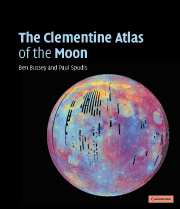Book contents
- Frontmatter
- Dedication
- Contents
- Preface to original edition
- Preface to revised edition
- Part I The Moon
- Introducing the Moon – its motions, properties and history
- A short history of early lunar exploration
- Recent lunar exploration: from Clementine to today
- A new golden age of lunar exploration
- Atlas details
- Part II The Clementine lunar atlas
- Plate section
Introducing the Moon – its motions, properties and history
Published online by Cambridge University Press: 05 September 2013
- Frontmatter
- Dedication
- Contents
- Preface to original edition
- Preface to revised edition
- Part I The Moon
- Introducing the Moon – its motions, properties and history
- A short history of early lunar exploration
- Recent lunar exploration: from Clementine to today
- A new golden age of lunar exploration
- Atlas details
- Part II The Clementine lunar atlas
- Plate section
Summary
Earth's Moon is mankind's first offshore island in space, an exotic world with its own unique properties. The Moon's motions and environment create challenges and opportunities. The following is a brief description of the general properties of the Moon, its motions and environment, surface, geology and history.
Basic properties and motions
The Moon is quite large in relation to the planet it orbits, measuring about one-quarter the radius of the Earth (Table 1). In surface area, the Moon at 38 million square kilometres is slightly larger than the continent of Africa. The tenuous lunar atmosphere is a near-perfect vacuum; no weather affects its terrain and the sky is perpetually black. Stars are visible from the surface during daytime, but difficult to see because the glare reflected from the surface dilates the pupils. At high noon, the surface temperature can be over 100 °C and, at midnight, as low as -150 °C. The lunar day (the time it takes to rotate once on its spin axis) is about 29 Earth days or 708 h, and daylight on the Moon (sunrise to sunset) lasts almost two weeks. Because the Moon has only 1% of the mass of the Earth, its surface gravity is only one-sixth as strong. Thus, an astronaut who weighs 200 lb on the Earth will weigh 34 lb on the Moon.
The Moon moves in an elliptical path around the Earth, completing its circuit once every 29 days. This equals the amount of time it takes for the Moon to rotate once on its axis (the lunar day).
- Type
- Chapter
- Information
- The Clementine Atlas of the Moon , pp. xv - xixPublisher: Cambridge University PressPrint publication year: 2004



